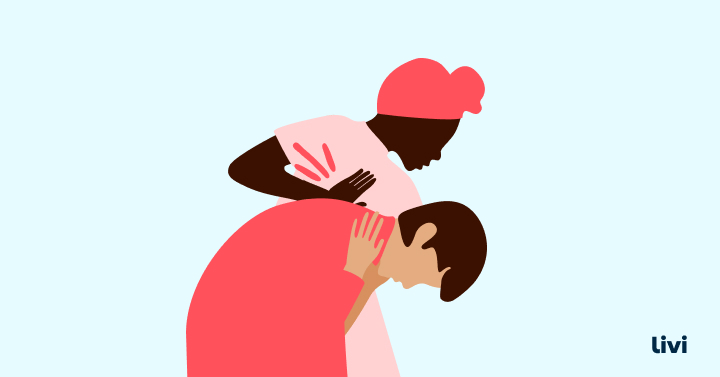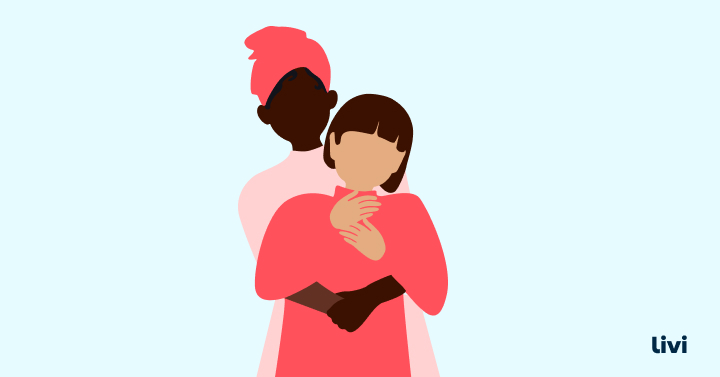Every year, hundreds of people are rushed to hospital after a choking incident, and hundreds more of these will be fatal. The elderly, young children and babies are particularly vulnerable. ‘Food such as grapes and nuts are common things to choke on – or anything else that’s not cut into small pieces,’ says Dr Rhianna McClymont, Lead GP at Livi. ‘Small toy parts, batteries and balloons are examples of other choking hazards for children too.’ ‘Choking can be a life threatening situation, but the best thing to do is stay calm, act quickly and follow the recommended first aid advice,’ Dr McClymont explains.
How should I help someone who’s choking?
A baby, child or adult will start choking and won’t be able to breathe if their airway becomes blocked, either fully or partly. The following advice is the same for adults and children (over 1 years old).
First of all, if their airway is only partly blocked, the person should be able to speak, cry, cough or breathe. You can help by doing the following:
- Encourage them to keep coughing to clear the blockage
- Ask them to spit out the object if it's in their mouth
- Keep your fingers away from their mouth
They'll usually be able to clear the blockage themselves. But if coughing doesn’t work, you need to act quickly and start doing back blows and abdominal thrusts.
When someone is choking and can’t dislodge the blockage by coughing, they won't be able to make any noise, speak or cry. If they don’t get help immediately to start breathing again, they will become unconscious.

How to give back blows
To carry out a back blow on an adult or child over 1 year old:
- Stand behind the person and slightly to one side
- Support their chest with one hand
- Lean them forward so the object blocking their airway will come out of their mouth, rather than moving further down
- Give up to 5 sharp blows between their shoulder blades with the heel of your hand (between your palm and wrist)
- Check if the blockage has cleared
- If not, give up to 5 abdominal thrusts

How to give abdominal thrusts
Abdominal thrusts should not be given to children under 1 year old or pregnant women.
To carry out an abdominal thrust on an adult or child over 1 year old:
- Stand behind the person
- Place your arms around their waist and bend them forward
- Clench your fist and hold it just above their belly button
- Put your other hand on top of your fist and pull sharply inwards and upwards
- Repeat this movement up to 5 times
If the person's airway is still blocked after trying back blows and abdominal thrusts, get help immediately:
- Call 999 and ask for an ambulance. Let the operator know the person is choking
- Continue with these cycles of 5 back blows and 5 abdominal thrusts until help arrives
If they lose consciousness and aren't breathing, you should start doing CPR (cardiopulmonary resuscitation). The aim of CPR is to pump blood around the person's body when their heart has stopped beating.
Although this can be a scary situation, it’s important to act quickly. We’ve put together a step by step guide on how to do CPR to help you stay calm.
Tips on helping a choking child
If you can see the object clearly in the child’s mouth, try to remove it. Don't poke blindly or repeatedly with your fingers – as you could make things worse by pushing the object further and making it harder to remove.
If your child is coughing loudly, encourage them to carry on coughing to bring up what they're choking on and don't leave them alone.
But if your child's coughing isn't helping to dislodge the blockage (or they’re not making a noise), shout for help immediately.
If your child's still conscious, but they're either not coughing or their coughing isn't working, start using back blows.
The advice is slightly different for a baby (a child under 1 year old), so if you’re a new parent it’s a good idea to familiarise yourself with what to do in this situation.
How do I stop a baby from choking?
Back blows
- Sit down and lay your baby face down along your thighs, supporting their head with your hand
- Give up to 5 sharp back blows with the heel of one hand in the middle of the back, between their shoulder blades
Chest thrusts
- Lay your baby face up along your thighs
- Find the breastbone and place 2 fingers in the middle
- Give 5 sharp chest thrusts (pushing their chest in and out by about a third)
Can you get complications from choking?
‘If you, your child or baby have any of the following symptoms after choking, it’s important to get medical help as soon as you can, either at A&E, an NHS walk-in centre or by a GP,’ says Dr Rhianna McClymont, Lead GP at Livi.
‘They will carry out various checks to make sure there are no complications or injuries.’
- A persistent cough after choking
- Throat still feels blocked
- Pain or discomfort from abdominal thrusts



